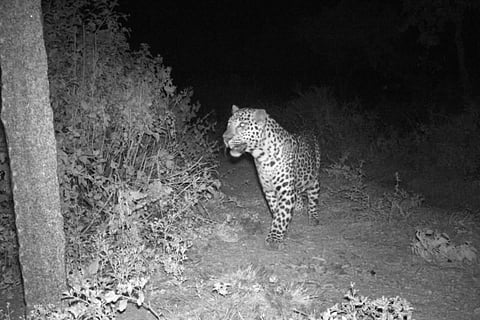

It’s not COVID-19 spread that has caused the Koppal district administration bar entry to a few shrines, including the famous Anjanadri hill temple located in Gangavathi taluk, but a leopard. After a person was mauled by a leopard in the vicinity of Anjanadri temple on November 5, forest officials appealed to the district administration to restrict the entry of devotees and visitors to the shrines from 8 am to 3 pm. They are concerned that human disturbance around the hill shrine could result in a rise in human-animal conflict.
But keeping in mind the safety of visitors, the Koppal Assistant Commissioner has stopped all entry to shrines in Anjanadri, Hanumanahalli, Pampa Sarovara, the Durgadevi Temple, among other pilgrim places in the taluk, which are spread over a 5-km radius from the Anjanadri temple. Forest officials are certain that a leopard is on the prowl in the region after a post-mortem of the person mauled recently revealed animal bite wounds, suspected to be that of a leopard.
In the past, a woman survived a leopard attack near Anegundi while a child and a tourist were reportedly attacked in the Gangavathi region. According to estimates, about 5 leopards reside in the vicinity of the temple. Sloth bears also share the habitat with leopards. In neighbouring Ballari, leopard attacks had killed two persons in 2018 while Tumakuru district reported five people killed by leopards in 2019-20.
Cage set up to trap leopard on the prowl
Defending the move to bar visitors, Koppal Deputy Conservator of Forests Dr Harsha Banu said that devotees/visitors who visit Anjanadri Hills unknowingly get too close to caves where leopards reside and may come in contact with the animal leading to conflict situations. The hill shrines in Gangavathi are the perfect habitat for leopards. He added that it was time people in the region be educated on staying away from the dangers of attacks by leopards and other animals.
Forest officials said that one way to capture the leopard on the prowl is to trap it in a cage. They rule out tranquilising the leopard based on expert opinion that the habitat is not ideal for this. Furthermore, forest officials are also not in favour of getting shoot-at-sight order from senior officials to eliminate problematic leopards.
A forest officer said that eight cameras had been installed in areas where the leopards move and a leopard was caught on one of them. Apart from cameras, seven cages have been set up to trap the leopard but it has eluded capture so far. A drone camera was also used to trace the leopard by forest officials.
Wildlife enthusiasts believe the attacks occurred when the persons were in a sitting position, the leopards attacking them thinking they were prey. However, Pompayya Malemath, a wildlife activist, said that the prey density of leopards had dwindled while earlier the region had a healthy deer population. To make matters worse, unchecked wild boar poaching in the region is causing food shortage for leopards and humans are falling prey to them now.
Apart from checking poaching of wild boars, Pompayya felt that if deer are reintroduced in the forests, then leopards, which are in good numbers, could prey upon them and mitigate the human-leopard conflict.
Forest officials heave a sigh of relief as the leopard on the prowl has not been sighted for some time in the Anjanadri Hills region. A forest source said stopping entry of visitors has been a good measure to avert leopard attacks.
Girisha is a freelancer who writes on wildlife and forests.